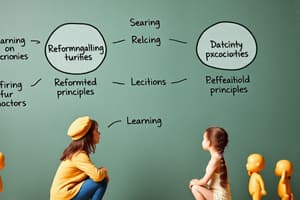Podcast
Questions and Answers
Which statement accurately describes the relationship between knowledge and learning, according to the text?
Which statement accurately describes the relationship between knowledge and learning, according to the text?
- Knowledge is a direct consequence of individual mental activity, while learning involves no interaction with existing information.
- Knowledge involves interaction between new information and existing understanding, while learning modifies or increases knowledge through experience and interaction with the environment. (correct)
- Knowledge and learning are synonymous, both referring to the passive reception of information from the environment.
- Knowledge involves interaction between old and new information, whereas learning is simply an increase in knowledge without modifying existing information.
In the context of Ausubel's meaningful learning, what is the role of 'anchoring ideas'?
In the context of Ausubel's meaningful learning, what is the role of 'anchoring ideas'?
- To discourage the connection of new information with real-world experiences.
- To replace existing knowledge with new information that contradicts it.
- To provide a structured framework for integrating new information with existing knowledge. (correct)
- To compartmentalize new knowledge into isolated areas.
What characterizes the 'elaboration of meanings' approach to learning, as understood by teachers?
What characterizes the 'elaboration of meanings' approach to learning, as understood by teachers?
- Students apply transmitted knowledge without interpreting it.
- Students construct knowledge autonomously, with the teacher guiding the process. (correct)
- Students primarily memorize facts provided by the teacher.
- Students passively receive and reproduce information with no interpretation.
During the activation phase of the teaching-learning process, what is the primary goal?
During the activation phase of the teaching-learning process, what is the primary goal?
What is the main purpose of concept mapping, according to the text?
What is the main purpose of concept mapping, according to the text?
Which of the following elements is NOT included as a component of attitudes?
Which of the following elements is NOT included as a component of attitudes?
How does a 'task' differ from an 'exercise' according to the text?
How does a 'task' differ from an 'exercise' according to the text?
What is the primary function of 'adaptaciones curriculares no significativas (ACI)'?
What is the primary function of 'adaptaciones curriculares no significativas (ACI)'?
What is the main goal of the 'retroalimentación' (feedback) phase in the teaching-learning process?
What is the main goal of the 'retroalimentación' (feedback) phase in the teaching-learning process?
Which of the following best describes the concept of 'competencia' as it is used in the text?
Which of the following best describes the concept of 'competencia' as it is used in the text?
Flashcards
What is Learning?
What is Learning?
A set of processes through which ideas, skills, habits, or values are acquired or modified, resulting from study, experience, instruction, reasoning or observation.
Learning as increment
Learning as increment
The student receives information and reproduces it. The teacher is the knowledge source.
Learning as Memorization
Learning as Memorization
The student stores information to associate and reproduce it exactly. The teacher provides knowledge.
Learning as acquisition
Learning as acquisition
Signup and view all the flashcards
Learning as abstraction
Learning as abstraction
Signup and view all the flashcards
Learning as Interpretation
Learning as Interpretation
Signup and view all the flashcards
Activation Phase goal
Activation Phase goal
Signup and view all the flashcards
Development Phase goal
Development Phase goal
Signup and view all the flashcards
Feedback Phase goal
Feedback Phase goal
Signup and view all the flashcards
Attending to diversity
Attending to diversity
Signup and view all the flashcards
Study Notes
- Learning involves acquiring or modifying ideas, skills, behaviors, or values through study, experience, instruction, reasoning, or observation
- Acquired knowledge can be represented and transmitted
Significance in Learning (Ausubel)
- An organized structure is held in areas of knowledge
- New knowledge should relate to real experiences to last
Key Variables
- Generality of anchoring ideas, more general ideas should include the more specific ideas
- Clarity and stability, clear ideas will have a more durable connection
- Discriminate similarities and differences
Approaches to learning
- Learning as quantitative increase of knowledge, students receive and reproduce information, the teacher provides
- Learning as memorization, storing information and associating it
- Learning as acquiring facts or procedures for use. students associate, reproduce and apply the knowledge
- Learning as abstraction of meanings, interpreting knowledge to reach a meaning
- Learning as an interpretive process aimed at understanding reality, where students build their own knowledge
Teaching-Learning Process
- Divided into activation, development and feedback phases
Activation Phase
- Main goal to activate existing knowledge to prepare the student
- Use organizers to provide structure, focus attention to introduce the topic attractively and use objectives.
Development Phase
- Knowledge transfer
- Students understand the organization and interrelation of elements
Feedback Phase
- The objective is to detect strengths and weaknesses and boost motivation.
- Teach concepts, procedures and attitudes
Concepts
- They categorize and organize serve to explain
- Connect with prior knowledge, enriching with successive approximations
Procedures
- Orderly actions directed at a goal
- Knowing how, know how to do it
Attitudes
- How one acts/thinks in certain situation
- Acquired attitudes include cognitive (ideas & beliefs), affective (feelings & emotions) and behavioral (actions) components.
Competency-Based Teaching
- The combination of knowledge, skills, and attitudes
- Dynamic and related to school learning
Competencies:
- Linguistic Communication (CCL)
- Plurilingual (CP)
- Mathematical, scientific, technological and engineering (STEM)
- Awareness and cultural expression (CCEC)
- Digital (CD)
- Personal, social and learn to learn (CPSAA)
- Citizenship (CC)
- Entrepreneurship (CE)
How to teach
Exercise
- Action to teach certain information, repeated to achieve memorization
- Not contextualized
Activity
- Action to gain new knowledge for comprehension and make decisions
- Contextualized with cognitive processes
Task
- Action in real life to solve a situation through mental processes
- Combining knowledge while putting skills into practice
Curriculum
- Objectives, skills, and content with teaching methods and criteria
- Programming: Actions that transform intentions into specific teaching proposals
Concretion levels
- State: laws, decrees
- Region: decrees, orders
- School: educational project
- Teachers: classroom programming
Specific measures for diversity
- Actions to adapt the teaching-learning process
- Promote education with equal learning opportunities
Universal Learning Design (ULD)
- Adaptations of access to the curriculum and no significant curricular
- Significant curricular adaptations
No Significant Curricular Adaptations (NSCA)
- Regular measures that all teachers can apply
- Preventative/compensatory
Aspects to take into account
- Methodological modifications
- Flexible groupings
- Adjust activities, temporal sequences, give more time
- Adapt tests or add pictograms
Studying That Suits You
Use AI to generate personalized quizzes and flashcards to suit your learning preferences.




